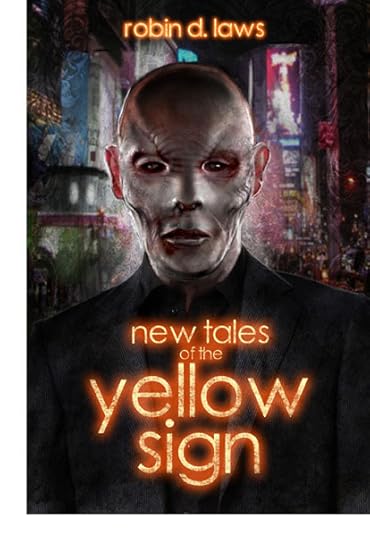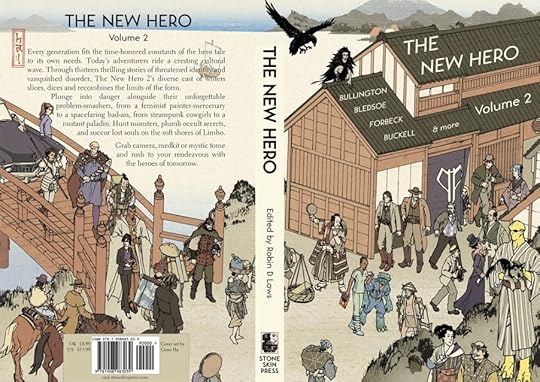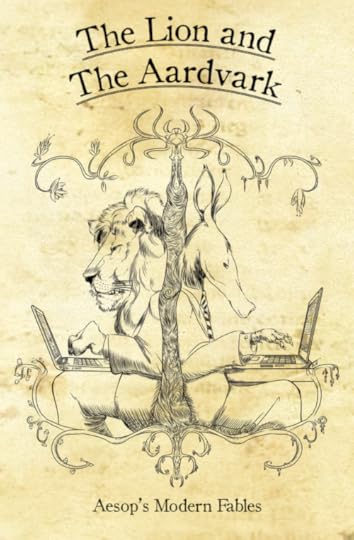Robin D. Laws's Blog, page 78
June 12, 2012
Why Hillfolk Lacks Magic, Laser-Wielding Dinosaurs
 Some gamers interested in DramaSystem have expressed a preference for an intial setting even more deeply geeky than a reimagined early Iron Age. Though no two ask for the same alternate setting. This excerpt from the rule book explains the choice of introductory setting.
Some gamers interested in DramaSystem have expressed a preference for an intial setting even more deeply geeky than a reimagined early Iron Age. Though no two ask for the same alternate setting. This excerpt from the rule book explains the choice of introductory setting.
In many classic roleplaying games, the characters become vehicles for the exploration of deep, endlessly fascinating settings. DramaSystem aims for a different sort of pleasure, one in which you leave the game remembering its people—the people you collectively created—and the things they did. To bring this experience to the forefront, it lets the background recede into, well, the background.
Hillfolk’s iron age setting is designed to appeal to at least one spectrum of geek-culture tastes, what with its swords, archaic period, imagined history, and epic clash of empires.
However, it does quite intentionally set aside a central element of popular nerdly properties. It takes place in a world without fantastical powers, whether granted by magic, futuristic technology, super mutations, or their various equivalents through other genres.
Beneath their genre-specific skinning, all of these function the same way. They’re super powers. They add flash, glamor and unique, trademarked detail to procedural stories.
By omitting the super powers, Hillfolk helps you to move faster to the heart of DramaSystem, the creation of dramatic narratives. The first time you play it, the group will, instinctively and understandably, lean toward the procedural scenes that drive other roleplaying games. Over time, as the play style manifests, procedural scenes become less frequent. Eventually you’ll start skipping over them, agreeing that certain practical outcomes have already occurred, in order to get back to the character interplay.
Having habituated yourselves to the style, you can move on to as outlandishly geeky a setting as your heart desires. Whatever flavor of super powers you choose will by that point support the game's core dynamic, instead of keeping you from it.
June 11, 2012
Tomes Fantasy Improv Show Postponed
 The fantasy/gaming-themed improv show I plugged last week has been indefinitely postponed. When organizers announce a new date I’ll let you know.
The fantasy/gaming-themed improv show I plugged last week has been indefinitely postponed. When organizers announce a new date I’ll let you know.
Make the Tabletop Forge Gang Think Up New Stretch Goals for their Kickstarter
 When the intrepid adventuring party behind Tabletop Forge, the app that turns Google+ Hangouts into a gaming table, announced their Kickstarter on the weekend, I figured I’d wait until weekday prime time to give their campaign a shout-out. Now I am late to the party, as they blew through their funding goal at jaw-dropping speed. Now they’re near to their stretch goal. Since further development will make this promising tool for online play an indispensable one, I say let’s test their ingenuity and see what other key inducements they come up with when they the top off that, too.
When the intrepid adventuring party behind Tabletop Forge, the app that turns Google+ Hangouts into a gaming table, announced their Kickstarter on the weekend, I figured I’d wait until weekday prime time to give their campaign a shout-out. Now I am late to the party, as they blew through their funding goal at jaw-dropping speed. Now they’re near to their stretch goal. Since further development will make this promising tool for online play an indispensable one, I say let’s test their ingenuity and see what other key inducements they come up with when they the top off that, too.
See P. XX, June Edition
 The latest edition of Pelgrane Press’ See P. XX now waves for your attention in modest yet dignified fashion. As always, it features an edition of my eponymous column, in this case devoted to the three ways in which we read RPG core books.
The latest edition of Pelgrane Press’ See P. XX now waves for your attention in modest yet dignified fashion. As always, it features an edition of my eponymous column, in this case devoted to the three ways in which we read RPG core books.
Alongside it in the grab bag of Pelgraney goodness: crowdfunding, Night’s Black Agents achievements and competition winners, playtest updates and opportunities, Owl Hoot Trail notes, and Simon Rogers’ latest progress report on the increasingly bustling world of Pelgrane. Check it out.
June 8, 2012
The Birds: Rehearsal

Click here for the complete strip archive.
Stuck in mobile mode? Click here for image file.
[image error]June 7, 2012
Improv Goes Fantasy – With a Hint of Hamlet’s Hit Points?
 Toronto’s coolest comedy venue is without a doubt Comedy Bar, at Bloor near Ossington. Although my favorite of the various sketch and improv formats is Catch-23, a competition in which teams have to play exactly that number of minutes worth of scenes before judge and voting audience, I may shortly have to revise that opinion, out of raw self-interest. Comic Doug Sheppard and a marauding band of fellow improvisers are unveiling Tomes, in which the group improvises based on the back cover copy of a fantasy novel they have never read. Curiouser still, Doug, who one must assume has some d20s under his furniture somewhere, got in touch to tell me that he drew some inspiration from Hamlet's Hit Points. I’ll be checking out the epic first performance on June 20th at 8 PM and reporting back afterwards. Keep up with Tomes events by liking their Facebook page.
Toronto’s coolest comedy venue is without a doubt Comedy Bar, at Bloor near Ossington. Although my favorite of the various sketch and improv formats is Catch-23, a competition in which teams have to play exactly that number of minutes worth of scenes before judge and voting audience, I may shortly have to revise that opinion, out of raw self-interest. Comic Doug Sheppard and a marauding band of fellow improvisers are unveiling Tomes, in which the group improvises based on the back cover copy of a fantasy novel they have never read. Curiouser still, Doug, who one must assume has some d20s under his furniture somewhere, got in touch to tell me that he drew some inspiration from Hamlet's Hit Points. I’ll be checking out the epic first performance on June 20th at 8 PM and reporting back afterwards. Keep up with Tomes events by liking their Facebook page.
June 6, 2012
Atomic Overmind Announces New Tales of the Yellow Sign Print Edition
 You asked for it, you got it. New Tales of the Yellow Sign, my upcoming collection of short stories inspired by the classic weird tales of Robert W. Chambers, will be available not only in ebook format, but in a print edition from Atomic Overmind Press. I’m happy to
You asked for it, you got it. New Tales of the Yellow Sign, my upcoming collection of short stories inspired by the classic weird tales of Robert W. Chambers, will be available not only in ebook format, but in a print edition from Atomic Overmind Press. I’m happy to  be able to accommodate the reading and collecting habits of the bibliomanes among you, and proud to be part of a line including Kenneth Hite’s Tour de Lovecraft and Cthulhu 101. Adding to the bragging rights, New Tales represents Atomic Overminder Hal Mangold’s first foray into straight-up fiction.
be able to accommodate the reading and collecting habits of the bibliomanes among you, and proud to be part of a line including Kenneth Hite’s Tour de Lovecraft and Cthulhu 101. Adding to the bragging rights, New Tales represents Atomic Overminder Hal Mangold’s first foray into straight-up fiction.
The print edition is scheduled for a September 2012 release, but we’ll sneak some advance copies to Gen Con, allowing attendees there the first shot at forever blasting their fragile mental conditions.
Once we go from cover mock-up (seen here) to finished cover, I’ll get the wheels in motion on ebook distribution. This is my first adventure in that format, and I’ll keep you updated as the electronic version wends its way to market.
Here’s the announcement text, as also found on the Atomic Overmind site.
In the dying years of the 19th century, a book changed the world—or worlds. A slim, sinister text called The King in Yellow drove those who read it to madness. Despite suppression by anxious authorities, it spread through global culture, and history itself, like a virus. Now the contagion bears hideous fruit.
Disturbing, dissonant and riddled with negative capability.
- Simon Rogers, Pelgrane Press
New Tales of the Yellow Sign expands the classic horror mythos of weird tales pioneer and Lovecraft precursor Robert W. Chambers into new vistas of unease and imagination. Over the course of eight troubling stories, writer and visionary game designer Robin D. Laws lures you into diseased timelines, impossible pasts, and the all-too-terrifying present.
Poison and beauty lie before you, in any color you want.
– Kenneth Hite, author, Tour de Lovecraft: The Tales
Sterilize your suicide chamber, harken to the remorseless clicking of your black box, and whistle for the monstrous creature that lives in your basement. The pallid mask awaits.
All of these New Tales of the Yellow Sign orbit lost Carcosa, black star points poked through the white scrim of consensus reality by the force of Chambers’ book. But each swings past on its own trajectory, a mix of styles and concerns in counterpoint to Chambers’ unified “Gallic studio atmosphere” of the Yellow Decade. Each story launches itself in fugue from one (or more) of Chambers’ originals, passages that Laws plays adagio or largo on different instruments, plays for modern dancers and not Victorian wallflowers.
– Kenneth Hite, from his Foreword
New Tales of the Yellow Sign is a 170-page trade paperback from Atomic Overmind Press, acclaimed publishers of Tour de Lovecraft: The Tales, and Cthulhu 101.It will release in September of 2012, with a preview release at the Gen Con Indy 2012.
The novels of author and game designer Robin D. Laws include Pierced Heart, The Rough and the Smooth, and The Worldwound Gambit. Robin created the GUMSHOE investigative roleplaying rules system and such games as Feng Shui, The Dying Earth, The Esoterrorists and Ashen Stars.
Atomic Overmind Press is an Alexandria, Virginia-based publishing house, founded in 2008. The Overmind and his creative partners are dedicated to bringing the best in esoteric science-fiction, fantasy, horror, fringe culture, and hobby gaming to a global audience. [image error]
June 5, 2012
90% Vampires
 As someone who has himself been guilty of diagramming out narrative structures, I recently had my attention directed to an infographic alleged to depict the thematic content of a particular book. On first glance, this looks cool, and not unlike the slow downward progress of a Hamlet’s Hit Points beat analysis map.
As someone who has himself been guilty of diagramming out narrative structures, I recently had my attention directed to an infographic alleged to depict the thematic content of a particular book. On first glance, this looks cool, and not unlike the slow downward progress of a Hamlet’s Hit Points beat analysis map.
When you check out what it actually measures, the wonkiness surfaces. Welcome to the blissfully obtuse world of the Book Genome Project, which measures the quantity of certain tropes and motifs, which it seems to think are the same thing as themes. It bases itself on the already peculiar assumptions of the Music Genome Project, which powers the Pandora streaming service. The MGP thinks that people choose music based on abstract, objective criteria like “major key tonality” or a “dynamic male vocalist.” Actually we respond more according to cultural aspiration, identity formation, and the indefinable talent of people working within the styles we’re already drawn to. When Pandora works, it’s because of its user fine-tuning.
Gene-sequenced music seems downright on-point compared to judging a book by the quantity of attention given to a motif or trope in a work of literature. This leads to such hilarity as the following gem, from the Book Lamp FAQ. (BISAC is the standard subject header system, as seen on a book’s front matter page.)
A book with 90% Vampires is a very different book than one with 5% Vampires, but both would probably receive the same label in the BISAC classification.
Clearly the above was typed by an android.
We as readers might respond to certain tropes and motifs, seeking some and staying clear of others. But they are externals, and tell us nothing about why one story using a motif becomes a staple of the canon and countless others vanish from the collective imagination.
Believe me, I didn't want to take the glasses off for this one. But if we’ve learned nothing else here today, vampires are not a theme! [image error]
June 4, 2012
With New Hero 2 Cover, Gene Ha Out-Awesomes Himself
 For the fiction writer, the process of having one’s work illustrated serves up anxiety by the bucket load. You are not only at at a remove from the art direction process, but often out of the loop altogether. Instances of character images being shaped more by inattentive illustrators than the text abound in genre literature. And that’s for novels. The idea that you’d have significant input into a short story cover lies beyond the silver veil of authorial dreams.
For the fiction writer, the process of having one’s work illustrated serves up anxiety by the bucket load. You are not only at at a remove from the art direction process, but often out of the loop altogether. Instances of character images being shaped more by inattentive illustrators than the text abound in genre literature. And that’s for novels. The idea that you’d have significant input into a short story cover lies beyond the silver veil of authorial dreams.
That an artist would take it on himself to communicate with the writers of a short story collection, taking heed of their input and making adjustments accordingly—why, that’s got to be a crazy myth, on the order of the unicorn. That the artist would then labor to include every single lead character in a collection of fourteen—often with sidekick? Why, that’s a chocolate unicorn riding a platinum unicorn atop a prompt cable installer.
Unless we’re talking Gene Ha, in which case it is just Gene being Gene. Here’s his cover for Stone Skin Press’ The New Hero 2.

As part of our deal when I agreed to sign on as Stone Skin’s Creative Director, Simon Rogers required that I occasionally include my own stories in these anthologies, no matter how unCanadian that might make me feel. The yellow dude with the German shepherd is Longthought, my mutant hero of the semiotic apocalypse, from the story “Among the Montags.”
[image error]June 1, 2012
The Lion and the Aardvark cover reveal
As previously touted hereabouts, Pelgrane Press is launching a fiction imprint, Stone Skin Press, with yours truly serving as Creative Director. The fourth book in our series of genre-busting anthologies will be The Lion and the Aardvark, a collection of modern fables from an impressive talent roster from writing scenes near and far.
Today we unveiled a cover mock-up to highlight the splendid illustration by Jim Zub, of Skullkickers and Udon fame. It brings a 1900s editorial cartoon style to the dueling laptops wielded by the opposed protagonists of Ekaterina Sedia’s title story.
I’m sure you’ll agree that Jim’s work more than meets the gold standard already set by Stone Skin cover artists, Gene Ha and Jason Morningstar.
We’re slating this for a Christmas release, so save space in your stockings.
 [image error]
[image error]



